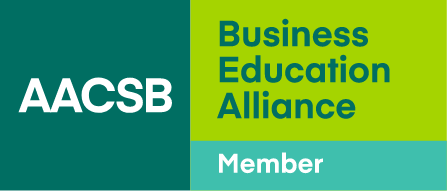Guiding Principles and Standards
FAQs - Guiding Principles and Standards
Standard 3 – Faculty and Professional Staff Resources
Does the overall faculty resource plan need to have a certain structure? Do we have to take special time period into account?
No, there is not a specific structure that needs to be followed. The school determines the best format to meet their needs. It is advisable to refer to the standard's basis for judgement, and the plan should project resource requirements (or targets) and define anticipated actions and an applicable timeline.
No, there is not a specific structure that needs to be followed. The school determines the best format to meet their needs. It is advisable to refer to the standard's basis for judgement, and the plan should project resource requirements (or targets) and define anticipated actions and an applicable timeline.
Standard 5 – Assurance of Learning
Standard 5 specifies a systematic process for assurance of learning. What do peer review teams usually expect in determining whether this standard is met?
The assurance of learning process is designed to ensure systematic continuous improvement of curriculum. Peer review teams will seek evidence that shows competencies for each degree program are in place. The standard does not describe what a school must do to have a “mature” AoL system. While a robust AoL system will have multiple competency goals for each degree program, AACSB does not prescribe an optimal number of competencies for a given degree program. Typically, schools will close the loop at least once in their accreditation cycle for each competency. AACSB interprets closing the loop to mean that a school shows how curriculum was improved as a result of the assurance of learning process. Results of the assessment should be documented and available for peer review teams upon request. The assessment processes and results should lead to documented continuous improvement in curriculum. Table 5-1 is mandatory for schools in the initial accreditation process and optional for schools completing their CIR report. However, all schools are encouraged to complete Table 5-1 as it presents assurance of learning data in an organized and standardized way for the benefit of the school and peer review team.
How often should a school review its learning competencies for each program?
There is no prescribed time frame for reviewing learning competencies. Schools are expected to have a systematic and sustainable way of reviewing curriculum as well as the assurance of learning process. As mentioned above, normally, schools “close the loop” at least once in their accreditation cycle for each competency goal. AACSB interprets closing the loop to mean that a school shows how curriculum was improved as a result of the assurance of learning process. Specifically, data from a second measure allows faculty, a peer review team, or other engaged stakeholders, to judge whether the curriculum improvements that were driven by the first round of data/results have been effective in helping students learn and/or perform better.
Must all students be assessed?
Assessment data collected from valid statistical samples of student work is acceptable to support conclusions about learning outcomes and identification of areas for improvement. Sample characteristics should be established to provide a high degree of confidence that the data are representative, valid, and reliable.
What is the minimum performance standard?
AACSB does not have a prescribed standard. The goal or benchmark for overall student performance on any given learning competency should be determined by each school consistent with its mission, degree programs, and student profile. This performance level provides a basis to determine if the collective student performance on any given learning competency is acceptable or unacceptable. If performance is unacceptable, curricula change should follow to address the problem.
Must all graduates meet the expected standard on all learning goals?
No, but the learning goals do represent the intentions of the faculty for every student. If students are not achieving the learning goals at acceptable levels, action must be taken to strengthen the curriculum for future students.
How many competency goals are needed?
The standards do not prescribe the number of learning goals a school must define for each degree program. Many schools specify 4-10 learning goals for each degree program. There is no limit, but this is guidance in order to keep the assessment program manageable.
The standards state that if five percent or more of total annual resources come from executive education, the school should have a process to ensure high quality and continuous improvement. Could you provide a definition of annual resources? Does this include state funds, profit centers within the college (i.e. executive ed, research bureau)?
There is some flexibility in this standard. Some schools with less than 5 percent of their resources coming from executive education may choose to include it within their scope. The 5 percent is of the total annual resources including all sources of funding, even endowments. The expectation is that a school that includes executive education in its review will present a portfolio of executive education programs and describe how the portfolio is aligned with the school’s mission and strategy. The school should also provide a narrative discussing how the school ensures high-quality processes and outcomes in its executive education offerings.
The assurance of learning process is designed to ensure systematic continuous improvement of curriculum. Peer review teams will seek evidence that shows competencies for each degree program are in place. The standard does not describe what a school must do to have a “mature” AoL system. While a robust AoL system will have multiple competency goals for each degree program, AACSB does not prescribe an optimal number of competencies for a given degree program. Typically, schools will close the loop at least once in their accreditation cycle for each competency. AACSB interprets closing the loop to mean that a school shows how curriculum was improved as a result of the assurance of learning process. Results of the assessment should be documented and available for peer review teams upon request. The assessment processes and results should lead to documented continuous improvement in curriculum. Table 5-1 is mandatory for schools in the initial accreditation process and optional for schools completing their CIR report. However, all schools are encouraged to complete Table 5-1 as it presents assurance of learning data in an organized and standardized way for the benefit of the school and peer review team.
How often should a school review its learning competencies for each program?
There is no prescribed time frame for reviewing learning competencies. Schools are expected to have a systematic and sustainable way of reviewing curriculum as well as the assurance of learning process. As mentioned above, normally, schools “close the loop” at least once in their accreditation cycle for each competency goal. AACSB interprets closing the loop to mean that a school shows how curriculum was improved as a result of the assurance of learning process. Specifically, data from a second measure allows faculty, a peer review team, or other engaged stakeholders, to judge whether the curriculum improvements that were driven by the first round of data/results have been effective in helping students learn and/or perform better.
Must all students be assessed?
Assessment data collected from valid statistical samples of student work is acceptable to support conclusions about learning outcomes and identification of areas for improvement. Sample characteristics should be established to provide a high degree of confidence that the data are representative, valid, and reliable.
What is the minimum performance standard?
AACSB does not have a prescribed standard. The goal or benchmark for overall student performance on any given learning competency should be determined by each school consistent with its mission, degree programs, and student profile. This performance level provides a basis to determine if the collective student performance on any given learning competency is acceptable or unacceptable. If performance is unacceptable, curricula change should follow to address the problem.
Must all graduates meet the expected standard on all learning goals?
No, but the learning goals do represent the intentions of the faculty for every student. If students are not achieving the learning goals at acceptable levels, action must be taken to strengthen the curriculum for future students.
How many competency goals are needed?
The standards do not prescribe the number of learning goals a school must define for each degree program. Many schools specify 4-10 learning goals for each degree program. There is no limit, but this is guidance in order to keep the assessment program manageable.
The standards state that if five percent or more of total annual resources come from executive education, the school should have a process to ensure high quality and continuous improvement. Could you provide a definition of annual resources? Does this include state funds, profit centers within the college (i.e. executive ed, research bureau)?
There is some flexibility in this standard. Some schools with less than 5 percent of their resources coming from executive education may choose to include it within their scope. The 5 percent is of the total annual resources including all sources of funding, even endowments. The expectation is that a school that includes executive education in its review will present a portfolio of executive education programs and describe how the portfolio is aligned with the school’s mission and strategy. The school should also provide a narrative discussing how the school ensures high-quality processes and outcomes in its executive education offerings.
Standard 6 – Learner Progression
Concerning Standard 6, what does a school need to disclose publicly?
In addition to public disclosure information required by national or regional accreditors, schools are expected to provide readily accessible, reliable, and easily understandable information to the public on the performance of their business students, including learner achievement information and overall program quality, as determined by the school. Disclosures are not prescriptive but are informed by the school’s mission, strategies, and expected outcomes, and may include post-graduate learner success outcomes, admission data, retention and time-to-degree data, placement data, or other mission-specific outcomes. This information should be available on the accredited unit’s website where it is clearly displayed and distinguishable from university amalgamated data.
What are the AACSB standards for MBA/executive MBA candidates who have not earned a bachelor's degree?
Standard 6: Learner Progression articulates a general expectation from AACSB’s view point that students admitted into graduate programs will have earned a bachelor’s degree. However, the school may choose to allow exceptions, but it should be prepared to demonstrate how these exceptions support quality and align with the school’s mission.
In addition to public disclosure information required by national or regional accreditors, schools are expected to provide readily accessible, reliable, and easily understandable information to the public on the performance of their business students, including learner achievement information and overall program quality, as determined by the school. Disclosures are not prescriptive but are informed by the school’s mission, strategies, and expected outcomes, and may include post-graduate learner success outcomes, admission data, retention and time-to-degree data, placement data, or other mission-specific outcomes. This information should be available on the accredited unit’s website where it is clearly displayed and distinguishable from university amalgamated data.
What are the AACSB standards for MBA/executive MBA candidates who have not earned a bachelor's degree?
Standard 6: Learner Progression articulates a general expectation from AACSB’s view point that students admitted into graduate programs will have earned a bachelor’s degree. However, the school may choose to allow exceptions, but it should be prepared to demonstrate how these exceptions support quality and align with the school’s mission.
Standard 8–Impact of Scholarship
When filling out Table 8-1, may we change the intellectual contribution columns or add columns?
Editing or adding columns is not recommended. If a school wants to provide further explanation, we suggest footnoting the item in question and providing additional information elsewhere.
Are all faculty intellectual contributions or just participating faculty ICs to be included on Table 8-1?
All intellectual contributions being produced by faculty contributing to the mission of the business school should be included on Table 8-1, including those that are being produced by Supporting faculty (if applicable).
In Table 8-1, how are co-authored intellectual contributions properly reflected?
In Table 8-1 co-authored intellectual contributions would be fractionally apportioned for co-authors at the same institution from business disciplines so as not to double-count the article in the table. For example, professor X in Accounting and professor Y in Finance co-author a peer-reviewed journal article. Each professor would get .5 allocation for that co-authored piece. When considering co-authored publications between an author from a business discipline and an author outside of a business discipline, the author from the business discipline who would be included in Table 8-1 would get 1 allocation. For example, professor M in Marketing and professor N in Psychology co-author a peer-reviewed journal article. Professor M would get 1 allocation for the piece and his/her contribution would be included in table 8-1.
On Table 8-1, should we include intellectual contributions from faculty that have left during the reporting period?
Intellectual contributions from faculty that left the school during the reporting period (i.e. year of record) may be counted in Table 8-1. However, if the faculty left prior to the reporting period (e.g. in year 3), then their intellectual contributions would not be included in Table 8-1.
In Standard 8, does the "Portfolio of IC's" in sum have to be the same as the sum of the "Types of IC's"?
Yes, the sum for each overall category (Portfolio of ICs and Types of Intellectual Contributions) should equal each other. The specific types of intellectual contributions would be extracted from the Portfolio of ICs (Basic or Discovery Scholarship; Applied or Integration/Application Scholarship; and Teaching and Learning Scholarship).
Is the production of new chapters and substantial revision of chapters in new editions sufficient to classify a faculty member as scholarly practitioner?
A case could be made for this as the activities are current, sustained, and substantive so long as the school’s criteria, in keeping with its mission, allow for this type of scholarly activity. Classifying an unbalanced number of faculty members with the activities described as SP could impact the school's ability to align with standard 8.
Editing or adding columns is not recommended. If a school wants to provide further explanation, we suggest footnoting the item in question and providing additional information elsewhere.
Are all faculty intellectual contributions or just participating faculty ICs to be included on Table 8-1?
All intellectual contributions being produced by faculty contributing to the mission of the business school should be included on Table 8-1, including those that are being produced by Supporting faculty (if applicable).
In Table 8-1, how are co-authored intellectual contributions properly reflected?
In Table 8-1 co-authored intellectual contributions would be fractionally apportioned for co-authors at the same institution from business disciplines so as not to double-count the article in the table. For example, professor X in Accounting and professor Y in Finance co-author a peer-reviewed journal article. Each professor would get .5 allocation for that co-authored piece. When considering co-authored publications between an author from a business discipline and an author outside of a business discipline, the author from the business discipline who would be included in Table 8-1 would get 1 allocation. For example, professor M in Marketing and professor N in Psychology co-author a peer-reviewed journal article. Professor M would get 1 allocation for the piece and his/her contribution would be included in table 8-1.
On Table 8-1, should we include intellectual contributions from faculty that have left during the reporting period?
Intellectual contributions from faculty that left the school during the reporting period (i.e. year of record) may be counted in Table 8-1. However, if the faculty left prior to the reporting period (e.g. in year 3), then their intellectual contributions would not be included in Table 8-1.
In Standard 8, does the "Portfolio of IC's" in sum have to be the same as the sum of the "Types of IC's"?
Yes, the sum for each overall category (Portfolio of ICs and Types of Intellectual Contributions) should equal each other. The specific types of intellectual contributions would be extracted from the Portfolio of ICs (Basic or Discovery Scholarship; Applied or Integration/Application Scholarship; and Teaching and Learning Scholarship).
Is the production of new chapters and substantial revision of chapters in new editions sufficient to classify a faculty member as scholarly practitioner?
A case could be made for this as the activities are current, sustained, and substantive so long as the school’s criteria, in keeping with its mission, allow for this type of scholarly activity. Classifying an unbalanced number of faculty members with the activities described as SP could impact the school's ability to align with standard 8.





